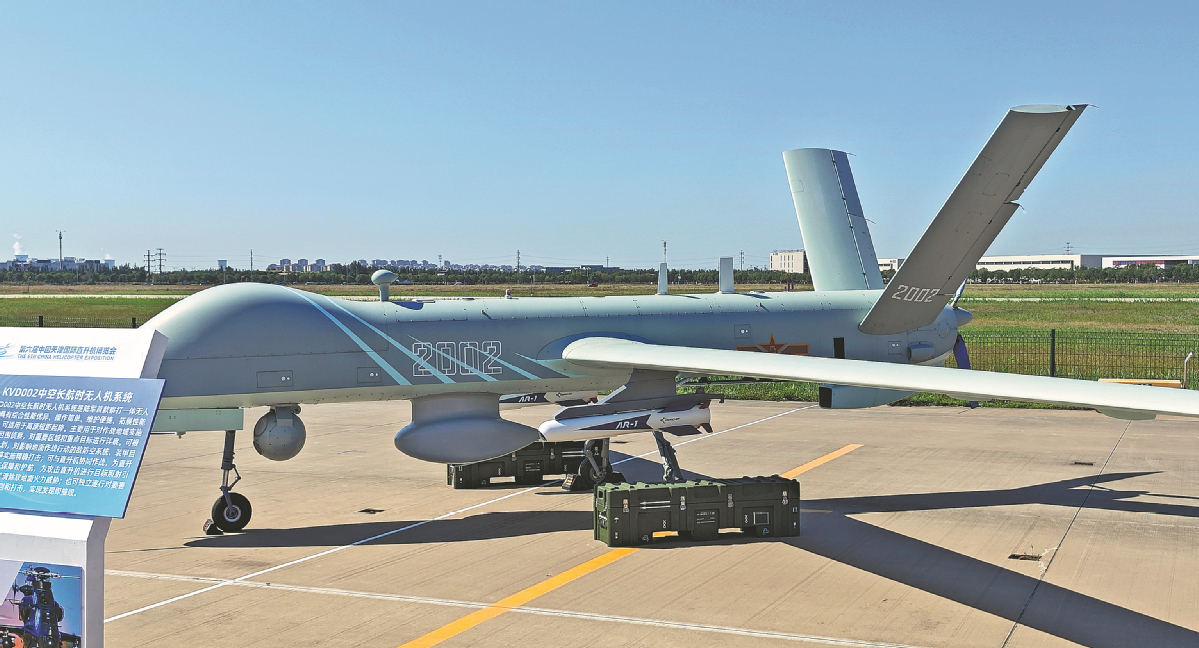The People’s Liberation Army Ground Force has recently unveiled what it described as its first unmanned reconnaissance and strike aircraft, known as KVD002, which Chinese experts believe has been involved in patrols and exercises near Taiwan since 2022.
The KVD002 medium-altitude long-endurance unmanned aerial system debuted on September 17 at the 6th China Helicopter Exposition in Tianjin Municipality in North China.
Equipped with two AR-1 air-to-surface missiles under its wings and reconnaissance devices beneath its main body, the KVD002 can execute precise strikes on hostile air defense systems, armored targets, and fortifications in line with integrated air-ground plans.
Additionally, it can collaborate with helicopters to offer reconnaissance data, escort services, target guidance, and perform reconnaissance and strikes autonomously.
Chinese state media said the UAV model can execute short takeoffs and landings on elevated plateaus.
While the PLA Army has not officially disclosed the developer of the KVD002, Chinese state media reports have suggested that based on its configuration and the presence of the AR-1 missile, it is likely derived from the Cai Hong 4 or CH-4.
The CH-4, a product of China Aerospace Science and Technology Corporation (CASC), a state-owned aircraft manufacturer, resembles the MQ-9 Reaper drone manufactured by the US-based General Atomics Aeronautical Systems.

The reports indicate that the CH-4 has been purchased by over ten countries, making it China’s most popular drone.
However, neither the PLA Army nor the manufacturer have released official statements or remarks regarding the correlation between the KVD002 and the CH-4 unmanned aircraft system.
Apart from the PLA Air Force, armed reconnaissance drones have become standard equipment across all branches of the Chinese military.
According to military experts in China, the drone is deemed highly valuable for the Ground Forces, particularly in the reconnaissance domain, as it can sustain extended periods over combat zones, offering significant support.
KVD002 Engages In Operations Near Taiwan?
The KVD002 is thought to be a specialized variant derived from the highly renowned CH-4, crafted to cater to the unique requirements of the PLA Army.
A recent report from the Global Times, referencing insights from Chinese experts, strongly suggests that the KVD002 armed reconnaissance drone has likely been operational in patrols and strategic exercises around the island of Taiwan since the year 2022.
However, according to the experts, the drone was identified under the designation CH-4 during that time.
Commencing from September 2022, with no prior knowledge of the KVD002, the defense authority on Taiwan Island sporadically documented sightings of CH-4 armed reconnaissance drones during the PLA’s routine patrols and exercises surrounding the island, the report added.
These operations occasionally encompassed Z-10 attack helicopters and KVD001 reconnaissance drones operated by the PLA Army, illustrating the multifaceted approach of the PLA’s activities around the island.
On September 17, a Chinese People’s Liberation Army (PLA) CH-4 Rainbow unmanned combat aerial vehicle (UCAV) near Taiwan was observed, marking the first confirmed instance of its deployment in the vicinity of Taiwan.
“The newly introduced KVD002 can conduct reconnaissance missions around Taiwan and execute precise strikes when needed,” Fu Qianshao, a Chinese military aviation expert, told the Global Times.
In the lead-up to the CH-4’s expected induction into the PLA Army as the KVD002, the CH-4 had already established a substantial presence in the international market, with over 200 units sold on the global market by November 2022.
However, as of now, there is no substantial evidence to confirm the deployment of the recently unveiled drone in the vicinity of Taiwan.
Using military drones has exacerbated tensions between China and Taiwan over the past few months. From China’s perspective, these drones serve as a crucial means to gather crucial intelligence.
Conversely, for Taiwan, they represent the latest facet of China’s intensifying campaign of intimidation and psychological warfare, commonly referred to as “gray zone” tactics.
In its pursuit of territorial claims over self-governed Taiwan, China has significantly increased its military presence in the Taiwan Strait, continuously deploying fighter jets and naval vessels closer to the island.
According to the observers, this pattern aims to test Taiwan’s defense capabilities and substantially heightens the risk of a potential conflict.
- Contact the author at ashishmichel(at)gmail.com
- Follow EurAsian Times on Google News